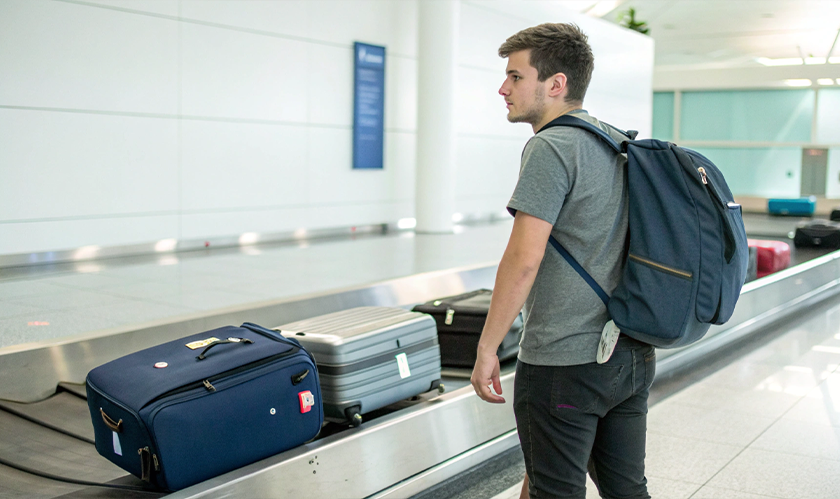Home Technology Aviation How Can You Secure Your Bags W...
Aviation

CIO Bulletin
07 November, 2025
Airports often feel crowded and fast-paced, making it easy for luggage to get lost or tampered with. Travelers who prepare before check-in and stay alert after arrival protect their belongings far better than those who rely only on airline systems. The best way to secure bags in busy airports is to combine smart packing, visible deterrents like TSA-approved locks, and real-time tracking tools that help locate luggage at any point in the journey.
A few simple habits can make a major difference. Photographing bag contents, labeling contact details clearly, and avoiding valuables in checked luggage reduce the risk of loss or theft. Travelers who invest in tamper-resistant suitcases or use discreet GPS tags also add an extra layer of protection that deters unwanted attention.
By understanding how baggage moves through airports and what thieves look for, travelers gain control over their belongings from departure to destination. The following sections explain proven methods to secure bags effectively and maintain peace of mind throughout the trip.
Travelers face higher risks of theft, loss, and damage in crowded terminals. Using durable luggage, proper locks, and clear identification helps protect belongings and reduce stress during air travel.
A sturdy suitcase provides the first layer of defense. Hard-shell models made from polycarbonate or aluminum resist crushing and tearing better than soft-sided bags. Reinforced corners and quality zippers help prevent splitting under pressure.
Lightweight materials make handling easier, but durability should come first. Some travelers use a smart luggage lock with tracking device to locate bags through connected devices,as this combination of physical and digital protection reduces the risk of loss.
Interior compartments and compression straps keep items from shifting. A suitcase with built-in locks and a water-resistant shell adds extra protection against rough handling or weather exposure.
A strong lock deters theft, but it must also meet airport security standards. TSA-approved locks allow agents to inspect bags without cutting them open. Travelers can choose between combinations or keyed versions based on preference.
High-quality locks resist tampering better than cheap ones that open with a pen or screwdriver. For those who prefer alternatives, cable ties or zip ties can secure zippers temporarily. They show clear signs of interference if cut, which discourages quick theft attempts.
Some travelers use smart locks that connect to mobile devices for added control. These locks can alert the owner if the bag moves unexpectedly, offering peace of mind in crowded terminals.
Zippers often serve as weak points. Pairing zipper pulls with small padlocks or plastic ties prevents easy access. This simple step also reveals tampering immediately.
Wrapping luggage in protective film at airport kiosks adds another layer of security. The wrap keeps moisture out and makes it harder for anyone to open the bag unnoticed. Travelers who prefer self-wrapping should leave handles and tags visible for inspection.
For duffel bags or backpacks, securing straps and removing detachable parts prevents snagging on conveyor belts. A quick inspection before check-in helps catch loose parts that could cause damage.
Distinctive luggage reduces mix-ups and theft. Bright colors, patterned straps, or unique tags make a suitcase stand out on the carousel. A colorful luggage strap also reinforces the bag and prevents accidental opening.
Travelers should remove old airline tags to avoid routing errors. Clear labeling with a name, phone number, and email helps recovery if the bag gets lost. Avoid listing a home address for privacy.
Adding a photo of the bag and its contents provides proof if it goes missing. This record speeds up claims and helps airline staff locate the correct suitcase quickly.
Travelers can reduce stress by keeping important items close, using tools to trace misplaced bags, and staying alert in crowded terminals. Simple habits and smart preparation can protect belongings and help recover lost or stolen luggage quickly.
Passengers should keep passports, cash, jewelry, electronics, and medications in their carry-on rather than checked luggage. These items are safer in sight and easier to access if a flight delay or baggage issue occurs.
A small pouch or organizer helps separate valuables from other items. It also speeds up security checks and prevents accidental loss. Travelers should use a carry-on that fits overhead bins to avoid forced gate checks.
Important documents such as boarding passes, identification, and travel insurance details should remain in an inside pocket or zipped compartment. This organization keeps sensitive information secure and ready for inspection if needed.
Technology can help locate missing luggage more quickly. Devices such as Bluetooth or GPS trackers allow travelers to see a bag’s location through a mobile app. This tool reduces uncertainty and helps airline staff narrow search areas.
Before departure, passengers should photograph their bags and note any unique features. A clear description improves recovery chances if a report is filed with the airline or airport’s lost and found.
Travel insurance that covers lost or stolen luggage can provide financial relief for replacement items. It also supports claims for delayed baggage. Keeping receipts for essential purchases after a loss helps document expenses for reimbursement.
Busy airports create opportunities for theft or confusion. Travelers should keep bags within reach and avoid leaving them unattended, even for a short time. A hand or strap on the handle discourages quick grabs.
Removing old tags prevents routing mistakes that could send bags to the wrong destination. Checking baggage tags at the counter confirms that the correct airport code appears on each label.
Security awareness continues after landing. Passengers should verify baggage claim numbers before picking up a suitcase and report any missing or tampered bags to airport staff immediately.
Travelers can reduce luggage problems by using simple habits and smart tools. A sturdy suitcase, quality lock, and clear identification tag help prevent theft or mix-ups. Small actions often make the biggest difference in keeping belongings safe.
Proper packing also protects items from damage. Placing heavier objects near the wheels and fragile ones in the center adds balance and security. Organized packing makes inspection faster and reduces stress during transit.
Awareness remains the best defense in busy airports. Staying alert at baggage claim and avoiding distractions helps travelers retrieve bags quickly. With steady attention and a few security steps, they can move through airports with confidence and peace of mind.







